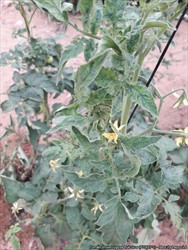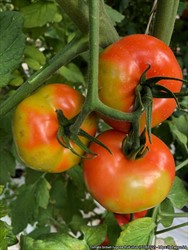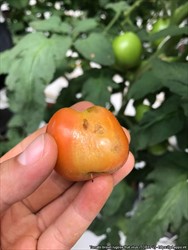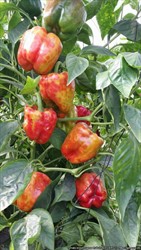Tomato brown rugose fruit virus
Pacific Pests, Pathogens, Weeds & Pesticides - Online edition
Pacific Pests, Pathogens, Weeds & Pesticides
Tomato brown rugose fruit virus (543)
Tomato brown rugose fruit virus. The abbreviation for the virus is ToBRFV. It is a member of the Tobamovirus group. Note, there are other important tobamoviruses: Tobacco mosaic virus, Tomato mosaic virus, Tomato mottle mosaic virus, and Pepper mild mottle virus. ToBRFV was first detected in 2016, and since then has spread rapidly.
Asia (China, Turkey), North America (Florida, Mexico), Middle East, Europe. The virus does not occur in Australia nor in any Pacific island country. It was first recognised in 2016, in Jordon, as a separate tobamovirus (plants grown under greenhouse conditions). Since then, it has spread to the Middle East, Europe, North America and China.
Tomato and capsicum. Note, eggplant and potato are not thought to be susceptible. No weed has been found to be naturally infected.
Tobamoviruses are very stable viruses, highly infectious and easily spread from plant to plant. ToBRFV infection on tomato results in leaves with mosaic (light and darker green patterns) and mottles (spots), distortions - dark green bulges or blisters on fully developed leaves (Photo 1). Sometimes leaves are smaller than usual. Fruit stalks and the leaf-like structures at the base of fruits (sepals of the calyx) decay resulting in failed fruit production. If produced, fruit may be deformed, and show brown or yellow 'marbling' (Photo 2), and wrinkled skin - hence the word 'rugose' in the name of the disease (Photo 3).
Symptoms on capsicum are similar: stunted seedlings; mosaics and puckering on leaves; mosaics, marbling and blotches on the fruits (Photo 4).
Co-infections with Pepino mosaic virus and Tomato spotted wilt virus (see Fact Sheet no. 481) have been reported.
Spread over short distances is from plant-to-plant contact. It also occurs through distribution of seeds, cuttings, infected plants. Mechanical transmission is possible, for instance, on tools, hands (during transplanting, pruning, tying, cultivation), and clothes.
Survival occurs in soil, water and nutrient solutions, on plant debris, tools and other equipment. In these situations, the virus may survive for many years. Note, tobamoviruses are not spread by insects as they feed, but they have been shown to be spread mechanically by bumblebees during pollination.
Although ToBRFV infects plants grown in the field, infections are more common on crops grown in greenhouses where the density of plants is higher and spread between them is likely to be greater.
The economic impacts of the virus on tomato production are considerable: there are direct costs, such as yield reduction of 30-70%, and indirect costs, those borne by growers or the industry: eradication programs; a lack of alternative crops that are as remunerative as tomatoes; a lack of resistant varieties so breeding programs need to be developed; seed treatments that raise the cost of production; and the deployment of increased hygiene measures.
Note that symptoms caused by other tobamoviruses listed under Scientific Name (above) are similar. For any one of them, diagnosis is not possible on symptoms alone, and molecular tests are required. The International Seed Federation (https://worldseed.org/) has developed ELISA and qPCR methods.
BIOSCECURITY
Quarantines are important in the management of this virus. Where they have been breached, eradication should be attempted immediately after identification by experts. In many cases, eradication has been successful as infections have occurred on crops grown under protected conditions. Consequently, it is important to identify the pathways for potential introduction of ToBRFV (and other tobamoviruses). Those of concern involve seed, seedlings, cuttings, grafts, and fruit.
There are regulatory phytosanitary testing programs required for the introduction of seed into the USA (https://seedworld.com/usda-taking-action-to-protect-the-u-s-from-tomato-brown-rugose-fruit-virus/), Europe and Australia (https://www.agriculture.gov.au/biosecurity-trade/import/goods/plant-products/seeds-for-sowing/emergency-measures-tommv-qa#how-will-the-emergency-measures-be-implemented). Importations of seed, seedling, and fruit of tomato and capsicum from countries where the virus is endemic (i.e., occurs frequently) should be regulated.
CULTURAL CONTROL
Before planting:
- Hygiene plan (seed):
- Source seed or seedlings from a reputable supplier or
- Treat seed with trisodium phosphate (TSP) - soak seed in 15% TSP for 20 minutes, or 2.5 hours in 10% TSP, changing the solution after 30 minutes. Stir during treatment, thoroughly rinse in water, dry and store in a clean container, not used previously for tomato or capsicum seed.
During growth:
- Hygiene plan (field or greenhouse):
- Monitor plants frequently for symptoms of tobaviruses and have the plants tested immediately if symptoms occur.
- Do not bring shop purchased tomatoes into close contact with those under propagation in the nursery, field or greenhouse.
- Restrict workers (and others) from visiting production areas, allowing only those who have implemented proper hygiene measures.
- Nursery areas for seedling production should be at distance from production areas (field or greenhouse).
- Use new potting mix or sterilise soil, and new or clean boxes for raising seedlings.
- Keep separate clothes, gloves, tools for each greenhouse or field. Do not mix them. Regularly disinfect tools using bleach (dilute sodium hypochlorite 1in 10 with water).
- Wash hands with soap or wear plastic disposable gloves before tying up, pruning or harvesting plants.
- Remove plants with signs of virus, trying not to touch adjacent plants.
After harvest:
- Collect the remains of plants after harvest and burn them. Do not keep plants for compost if they had shown signs of the disease.
- Use a 2-year rotation for tomato and capsicum on the same land.
RESISTANT VARIETIES
No commercial tomato varieties are known to be resistant to ToBRFV.
CHEMICAL CONTROL
Not a suitable method of control for this disease.
AUTHOR Grahame Jackson
Information from CABI (2020) Tomato brown rugose fruit virus (Tomato brown rugose fruit virus). Crop Protection Compendium. (https://www.cabidigitallibrary.org/doi/10.1079/cabicompendium.88757522); and Tomato brown rugose fruit virus, Department of Primary Industries. NSW Government. (https://www.dpi.nsw.gov.au/biosecurity/plant/insect-pests-and-plant-diseases/tomato-brown); and Tobamoviruses - tobacco mosaic virus, tomato mosaic virus and pepper mild mottle virus. Department of Employment, Development and Innovation, Agri-Science Queensland. Queensland Government. (https://www.daf.qld.gov.au/__data/assets/pdf_file/0017/71063/Tobamoviruses.pdf); and Tomato brown rugose fruit virus (2020) Cornell Vegetables. Resources for Commercial Growers. CornellCALS. College of Agriculture and Life Sciences. (https://www.vegetables.cornell.edu/crops/tomatoes/tomato-brown-rugose-fruit-virus/); and from Wyenandt A (2020) Understanding and Controlling Tomato Brown Rugose Fruit Virus. Plant & Pest Advisory. Rutgers Cooperative Extension. New Jersey Agricultural Experiment Station. (https://plant-pest-advisory.rutgers.edu/understanding-tomato-brown-rugose-fruit-virus/). Photos 1-4 Eppo Global Database (2016) Tomato brown rugose fruit virus (TOBRFV). (https://gd.eppo.int/taxon/TOBRFV).
Produced with support from the Australian Centre for International Agricultural Research under project HORT/2016/185: Responding to emerging pest and disease threats to horticulture in the Pacific islands, implemented by the University of Queensland and the Secretariat of the Pacific.







